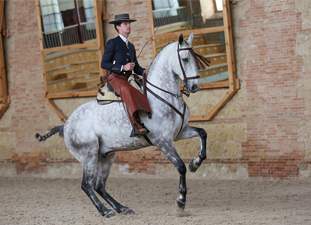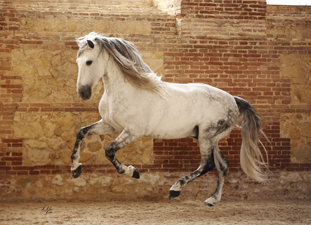Located just a short walk from the Mezquita, a UNSECO World Heritage Site are the historical Royal Stables of Cordoba, or Cordoba Ecuestre. With its vaulted ceilings, it resembles a cathedral for horses. The building was originally part of the Alcazar, built by King Felipe II in 1570. The king was a great lover of horses, so he set out on a scheme to create a pure thoroughbred Spanish horse. For this reason, he ordered the Royal Stables to be built on land belonging to the Castle of the Christian Monarchs. Like the castle, it is predominantly a military building. Here, he retained the best stallions and mares and carefully bred the Spanish horse, now known as the Andalusian horse, which is of Arab origin. The stable is another stunning example of Moorish architecture, and is located in a scenic setting in the historic district of Cordoba on the banks of the Guadalquivir River.
The Andalusian Horse became one of the greatest breeds of horse ever to exist, first for King Felipe’s own use, and now used by dressage enthusiasts all over the world. What was at first simply a royal wish ended up being one of the greatest and best-loved of Felipe II’s projects.
A tour of the Royal Stables of Cordoba offers a unique chance to marvel at the beauty and magic of the Andalusian Horse or Pura Raza Española. It is the breed of horse best associated with high dressage. Cordoba Ecuestre offers evening performances –“ The Passion and Spirit of the Andalusian Horse” which is a 90 minute spectacle of talented dancing horses and flamenco performance. The combination of the two has become the epitome of Spanish culture.
The Andalusian horse was first recognized as a distinct breed in the 15th century, however, their history goes back thousands of years on the Iberian Peninsula. Cave paintings in Spain have been found showing pictures of horses that date as far back as 30,000 BC. What distinguishes this breed is their long thick mane and tail, as well as their arched neck and elegant yet robust build. Because of their extreme athleticism, Andalusian horses were used in the past as war horses, as well as the preferred breed of nobility across Europe.
For true horse lovers, you can watch the horses during their afternoon practice session – a behind the scenes prelude to the evening performance. If you attend the practice session, you can wander the grounds or just sit and watch the horses with their trainers and riders as they practice their routines; you will also have the opportunity to interact with these stunning horses up close. Watching the horses come and go from their stalls, getting bathed, eating, and of course, performing is a real treat for anyone with a love for horses. There is also a carriage museum on site, which is a worthwhile stop whilst enjoying this historical site. The emblematic Royal Stables of Cordoba is a must for anyone visiting Andalusia. Join us at Cavago in celebrating this beautiful and historical horse. Book your ticket on Cavago and visit the majestic Royal Stables of Cordoba.


